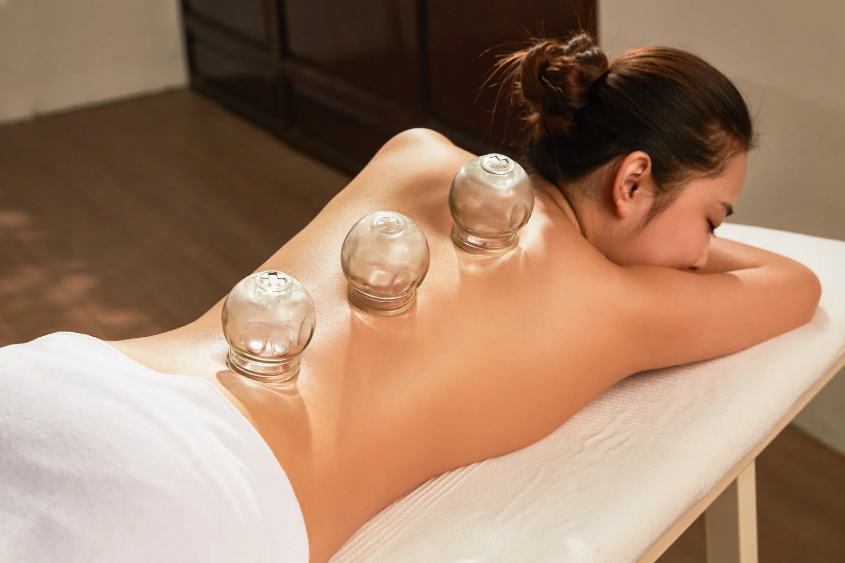Cupping therapy, an ancient healing practice, has gained significant attention in recent years due to its remarkable health benefits. While cupping has been used in traditional medicine for thousands of years, many people today are turning to this alternative therapy for pain relief, relaxation, and improved wellness. This therapy involves placing cups on the skin to create suction, which has been shown to stimulate blood flow, promote healing, and alleviate discomfort. In this article, we’ll explore the science behind cupping and its healing effects on the body.
What is Cupping Therapy?
Cupping therapy involves placing specially designed cups on the skin to create suction. This suction helps to increase blood flow and stimulate the body’s natural healing processes. There are different types of cupping, such as dry cupping, wet cupping, and fire cupping, each with its own method of creating suction. The practice has deep roots in traditional Chinese medicine, but it is also used in many other cultures worldwide.
The primary goal of cupping is to improve circulation and promote healing. When the cups are applied to the skin, they create a vacuum effect that draws the skin and underlying tissues upward. This process enhances blood flow to the area, which helps to release tension, alleviate pain, and improve overall wellness.
The Science Behind Cupping Therapy
The science behind cupping therapy lies in the way it affects the body’s tissues and circulatory system. When a cup is placed on the skin, the suction causes the blood vessels to expand, increasing blood circulation in the targeted area. This improved blood flow helps to promote the delivery of oxygen and nutrients to the tissues, while also encouraging the removal of toxins and waste products.
The mechanical process of cupping works by stimulating the lymphatic system. The increased circulation aids in the drainage of lymph fluid, which supports detoxification and boosts the body’s immune system. Moreover, cupping can help to release muscle tension by stretching the fascia—the connective tissue surrounding muscles—thereby reducing pain and stiffness.
From a neurological perspective, cupping has a direct impact on the nervous system. The suction created during a cupping session stimulates nerve endings in the skin, which sends signals to the brain to reduce pain and discomfort. By influencing pain receptors, cupping helps to manage conditions like chronic pain and muscle soreness.
The Healing Effects of Cupping Therapy
Cupping therapy offers a wide array of healing effects that support both physical and mental well-being. Here’s how cupping can benefit various aspects of your health:
Pain Relief
Cupping is widely known for its ability to relieve pain, especially in areas such as the back, neck, and shoulders. By improving blood circulation and reducing inflammation, cupping helps to ease discomfort associated with muscle stiffness, chronic pain, and tension. Scientific studies have demonstrated that cupping can reduce pain intensity and improve the quality of life for those suffering from musculoskeletal conditions.
Reducing Inflammation
Inflammation can lead to a host of health issues, including joint pain, swelling, and tissue damage. Cupping therapy helps to reduce inflammation by improving circulation and oxygenating the tissues. As blood flow increases to inflamed areas, the body is better equipped to repair damaged tissues and alleviate discomfort.
Improving Circulation and Oxygenation
One of the primary benefits of cupping is its ability to improve blood circulation. As the cups are applied to the skin, they draw blood to the surface, allowing oxygen and nutrients to reach the tissues more effectively. This enhanced circulation aids in muscle recovery, reduces fatigue, and promotes overall vitality. Cupping therapy is particularly helpful for athletes and individuals experiencing muscle soreness or stiffness.
Relaxation and Stress Relief
In addition to its physical benefits, cupping therapy also has profound psychological effects. The soothing nature of cupping helps to activate the parasympathetic nervous system, which induces a state of relaxation. By alleviating stress and anxiety, cupping helps individuals achieve a sense of calm and well-being. The therapy encourages the body to enter a state of deep relaxation, which can have long-lasting benefits for mental health.
Conditions That Benefit from Cupping Therapy
Cupping therapy has been used to treat a wide variety of conditions, ranging from physical pain to emotional stress. Here are some common conditions that can benefit from cupping:
Musculoskeletal Disorders
Cupping is particularly effective for individuals experiencing musculoskeletal pain, such as back pain, neck stiffness, or joint discomfort. By improving blood flow and reducing muscle tension, cupping helps to relieve pain and promote healing in the muscles and joints.
Respiratory Issues
Cupping therapy can be beneficial for individuals with respiratory conditions, such as asthma, bronchitis, and chronic cough. The therapy works by improving lung function and clearing congestion, making it easier to breathe. Many people use cupping as a natural remedy to improve respiratory health.
Digestive Problems
Digestive issues, such as bloating, constipation, and indigestion, can also benefit from cupping therapy. By stimulating the digestive organs and improving circulation to the gut, cupping helps to support better digestion and alleviate discomfort caused by digestive problems.
Skin Conditions
Cupping therapy is often used to treat various skin conditions, including acne, eczema, and psoriasis. The increased circulation and detoxification effects help to promote healthy skin by flushing out toxins and improving the skin’s overall appearance.
Is Cupping Therapy Safe?
While cupping therapy is generally considered safe, it is essential to ensure that it is performed by a trained professional. Some individuals may experience mild side effects, such as bruising, skin irritation, or dizziness, but these effects are typically temporary and subside within a few days.
Certain groups of people should avoid cupping therapy, including pregnant women, individuals with certain skin conditions, or those with a history of bleeding disorders. It is always recommended to consult with a healthcare provider before undergoing cupping therapy, particularly if you have any underlying health conditions.
How to Incorporate Cupping Therapy Into Your Wellness Routine
Cupping therapy can be a valuable addition to your wellness routine, but it is essential to know how often to use it for maximum benefit. The frequency of cupping sessions varies depending on individual needs, but most people find that regular sessions, once or twice a month, can help to maintain overall health.
For those looking to enhance the effects of cupping, it can be combined with other therapies, such as acupuncture, massage, or yoga. Together, these treatments work synergistically to support both physical and mental health.
Takeaway
Cupping therapy is a powerful and effective treatment with a range of healing effects. From pain relief and improved circulation to relaxation and detoxification, cupping offers a natural way to support your overall well-being. The science behind cupping is rooted in its ability to stimulate circulation, relieve tension, and promote healing in the body. If you’re seeking an alternative approach to healing, cupping therapy may be the answer you’ve been looking for.






